With hybrid and remote work schedules leaving millions of square feet of empty office space, “private owners are suffering,” says Eran Chen, a founder of the New York architecture firm ODA. “They may lose buildings to their banks; cities are losing real-estate tax dollars,” he adds. “And nobody likes an empty office district.”
Given the urgency of filling all the empty space, converting offices to residential use is seen as a twofer: making obsolete buildings useful again and allaying a national shortage of housing. Also, conversions can put units online quicker than new construction. Downtowns diversified by housing—and supplied with ample cultural and recreational amenities—draw more people. They extend 9-to-5 commercial monocultures to 18-hour “live/work/play destinations,” in real-estate shorthand.
Some architects advocate office-to-residential conversions as a climate-responsible solution, taking advantage of transit-rich neighborhoods and conserving the substantial embodied carbon of existing buildings, compared to new construction. (Estimates vary widely, but a building’s frame and its foundations alone can account for 30 percent of a building’s embodied carbon.) As SOM Adaptive Reuse Practice leader Frank Mahan puts it, “With a stagnant office market, a housing shortage, and climate change, we could address all three existential crises of our time at once.”
Several European countries and cities have regulations aimed at reducing emissions from building materials. In London, for instance, a requirement for building life cycle assessments of carbon intensity is tilting the playing field toward retaining and adapting buildings “because you have to compare the carbon footprint of the existing building to what you would build new,” explains Russell Fortmeyer, global sustainability leader for architecture firm Woods Bagot. In the U.S., Fortmeyer points to California’s recently instituted code limits for embodied carbon which apply to the construction and renovation of commercial buildings larger than 100,000 square feet. He maintains that the new regulations could make conversion the more affordable path, since project teams opting to build new will be competing for the limited supply of low-carbon materials, such as mass timber or green concrete, and thus paying a premium.
Though opportunistic politicians have harmfully vilified downtowns in older cities as hotbeds of crime and violence, the appeal of in-city living is largely undimmed, with many metro areas luring back those who left during the pandemic. Philadelphia has seen most of its housing growth in recent years in the downtown core and surrounding neighborhoods, according to Paul Levy, president and CEO of the Center City District, a business-improvement organization, and his city is hardly alone.
Office building conversions are not new, of course. However, a widely expected boom in such projects post-pandemic has not yet materialized, even as large-scale remote work persists. It turns out that the volatile financial and regulatory environment has made developers skittish. Conversions that could alleviate the dire shortage of affordable housing in the U.S. are even more daunting. These factors not only affect the viability of projects but also architectural approaches to them, as well as technological tactics.
Higher construction costs and interest rates—and uncertainty over where these are headed—make projects riskier and developers reluctant. “Everyone’s waiting for incentives,” says Adam Yarinsky, principal at Architecture Research Office (ARO), which can include some combination of tax abatements, relaxed building codes, and zoning bonuses. A 10-year tax abatement and a mixed-use zoning district have been in place in Philadelphia since 1996. “It has led to the conversion of 180 buildings of all sizes to residential use, including 9 million square feet of office space,” explains Levy, of the Center City District. After the 9/11 terror attacks, New York incentivized dozens of conversions of buildings in Lower Manhattan that had long languished. The current mayor, Eric Adams, hopes to bring such incentives to additional parts of the city that have underused office buildings, but so far these efforts have been thwarted by the need for state legislation that would enable them.
Conversion Candidates
Some kinds of office structures are easier to adapt than others. Since the late 1980s, many modest commercial buildings from the late 19th and early 20th centuries have been handsomely converted to residential use. These loft-style structures were built to be flexible, accommodating offices, wholesalers, and small industrial uses, and therefore often come with high ceilings, regular (if column-studded) floor plans, and tall windows.
Slim early 20th-century towers, many among the most famous buildings in their cities, have also proved desirable for residential conversion, particularly at the higher end of the market. Their shallow exterior wall-to-core distance and high ceilings bathe their interiors in daylight from windows that are often appealingly oversize. The $400 million transformation of the long-abandoned 1926 Book Tower in Detroit (Louis Kamper, original architect) into a combination of hotel rooms and rental apartments was “a simple conversion,” says ODA’s Chen, since the floor plates matched a residential-building depth, and it had an ample number of windows. In addition to designing the apartment layouts, his firm restored the exterior and extensively renovated a spectacular domed and vaulted art-glass lobby ceiling.
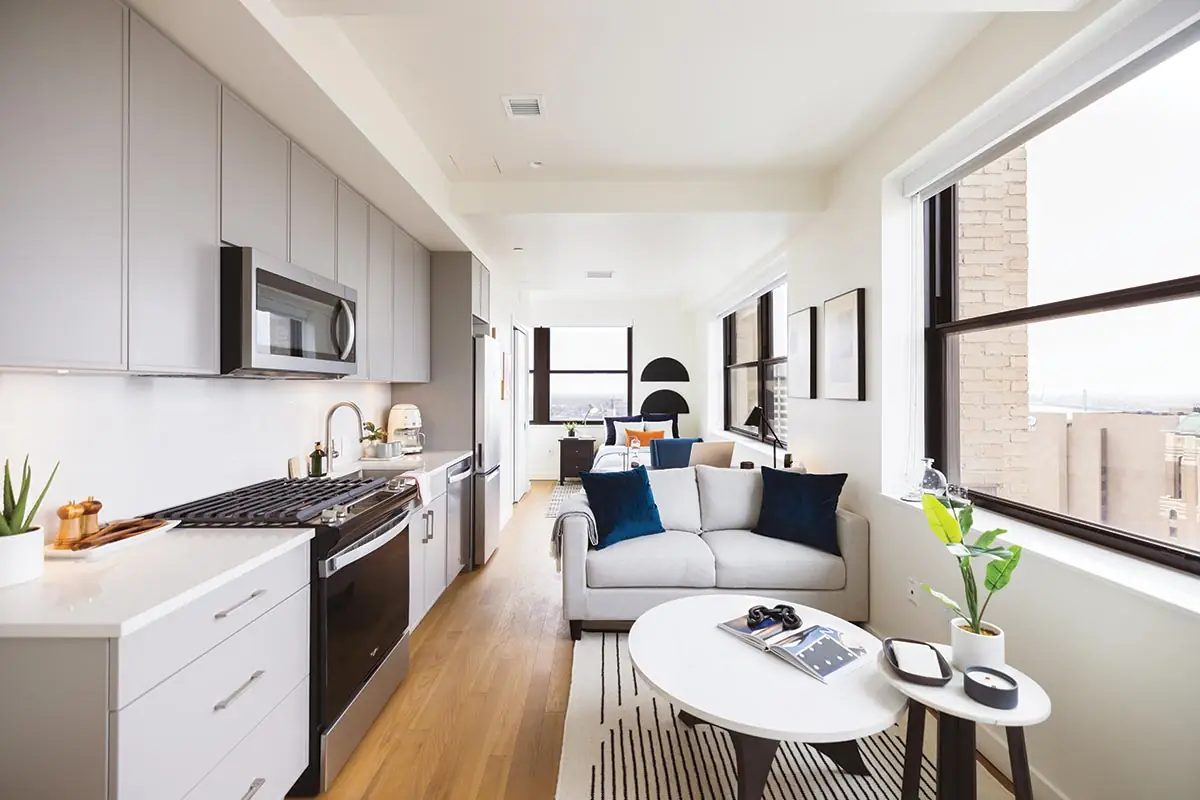
The Book Tower (top of page) in Detroit has a generous number of windows, making ODA’s conversion of the 1927 office tower into apartments (above) and hotel rooms relatively straightforward. Photo courtesy of Bedrock, click to enlarge.
In New York, recent conversions of early 20th-century towers include such trophy properties as Cass Gilbert’s Woolworth Building (1912), and the 1932 headquarters of Irving Trust, designed by Voorhees, Gmelin and Walker, with its elegantly slender silhouette and its restrained fluted-limestone surface. Frank Woolworth had dubbed his 792-foot tower, for a time the tallest building in the world, “the Cathedral of Commerce,” but in 2018, the late Thierry W. Despont, with SLCE Architects, converted its top 26 floors into 33 luxury apartments. The design team also fit a six-level penthouse within the building’s copper-clad pyramid-shaped roof. The lower 29 stories remain in use as offices.
The recently completed luxury conversion of Irving Trust, now called One Wall Street, was designed by an extensive team that included SLCE, MdeAS Architects, Ashe Leandro, and Deborah Berke Partners (now TenBerke) for Macklowe Properties. According to MdeAS principal, Dan Shannon, One Wall Street’s proportion of wall surface to oversize windows eased the task of laying out the apartments. (High-performance replacement windows were curved to match the fluting as the originals did.) Freestanding, it opens to views on all sides. “The quality of the architecture is part of the attraction, for people who don’t want cookie-cutter design,” he says.
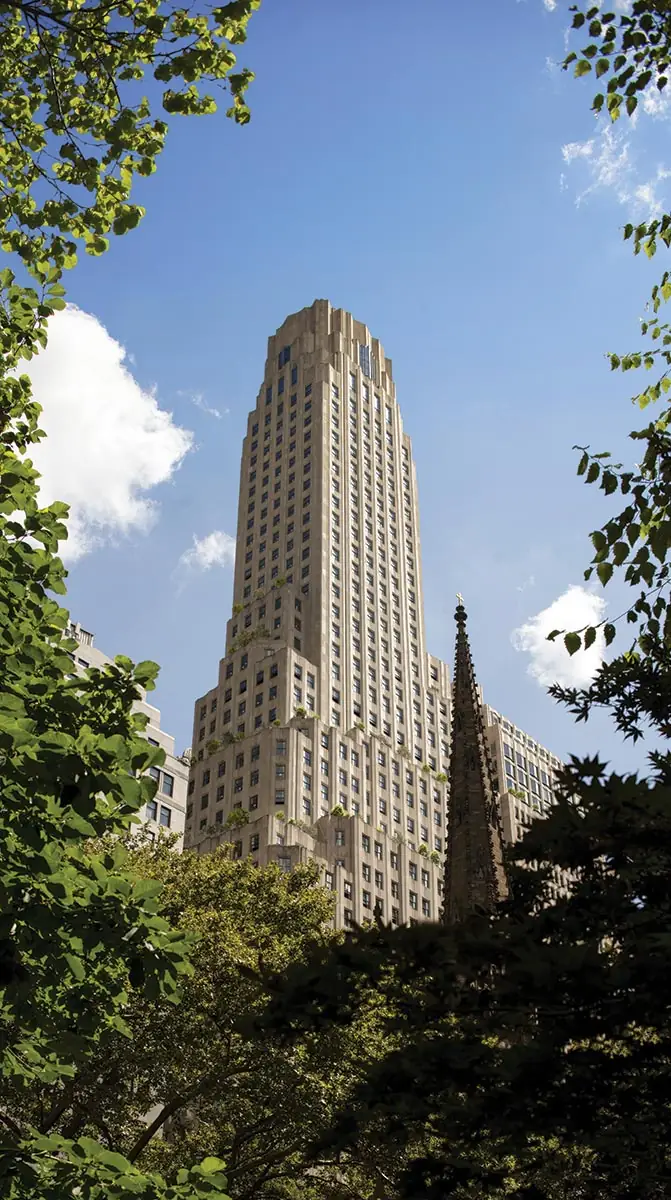
1
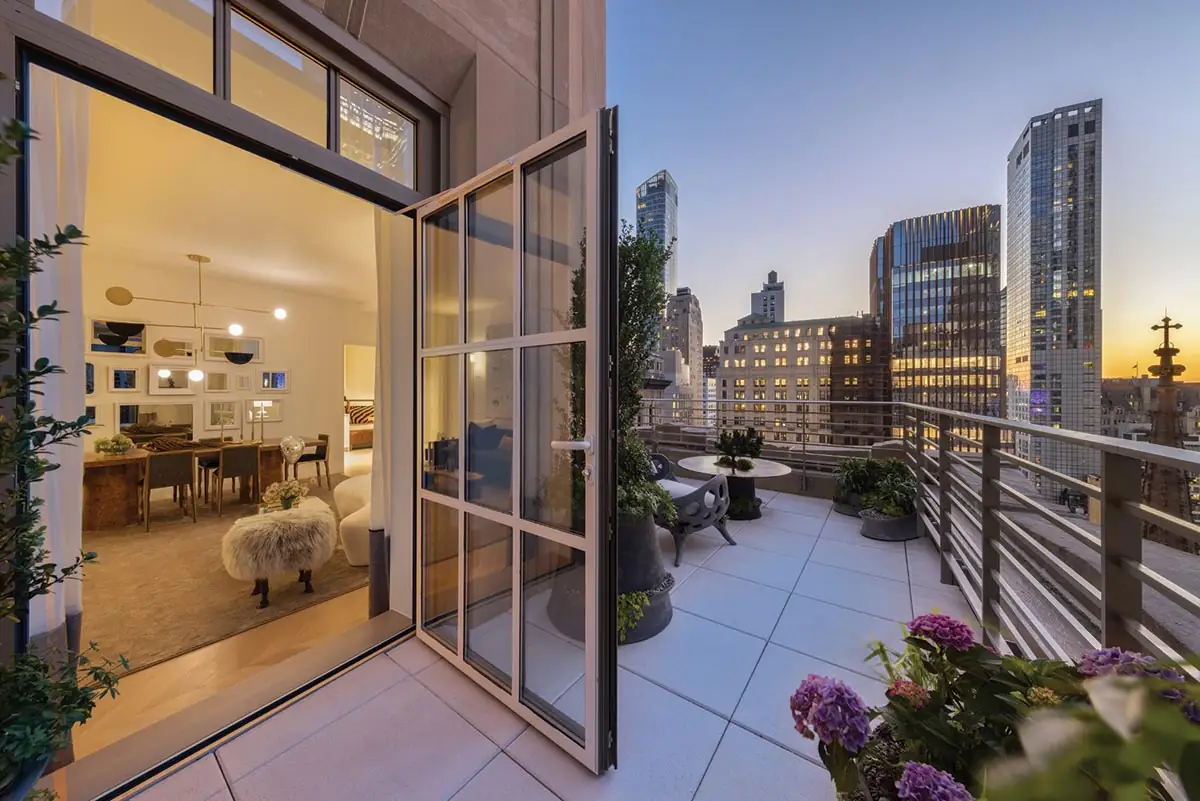
2
Along with a 1960s annex, the 1932 tower, built as the headquarters of Irving Trust (1), is now known as One Wall Street and houses 566 condominiums (2). Photos courtesy of Macklowe Properties: Evolution VR (1), Even Joseph (2)
As with Irving Trust, the famous neo-Gothic architecture of Chicago’s Tribune Tower (John Mead Howells and Raymond Hood)—with sweeping views from its upper floors and relatively shallow floor plates (ranging from 13,000 on lower levels to 1,800 square feet near the top)—made the 1925 skyscraper well suited to luxury-apartment layouts. Architects SCB transformed the tower into 162 condominiums of 56 unique layouts. Since the building’s population is lower in its residential incarnation, the architects shaped a more compact core, removing six of nine elevator shafts and replacing some with a relocated exit stair.
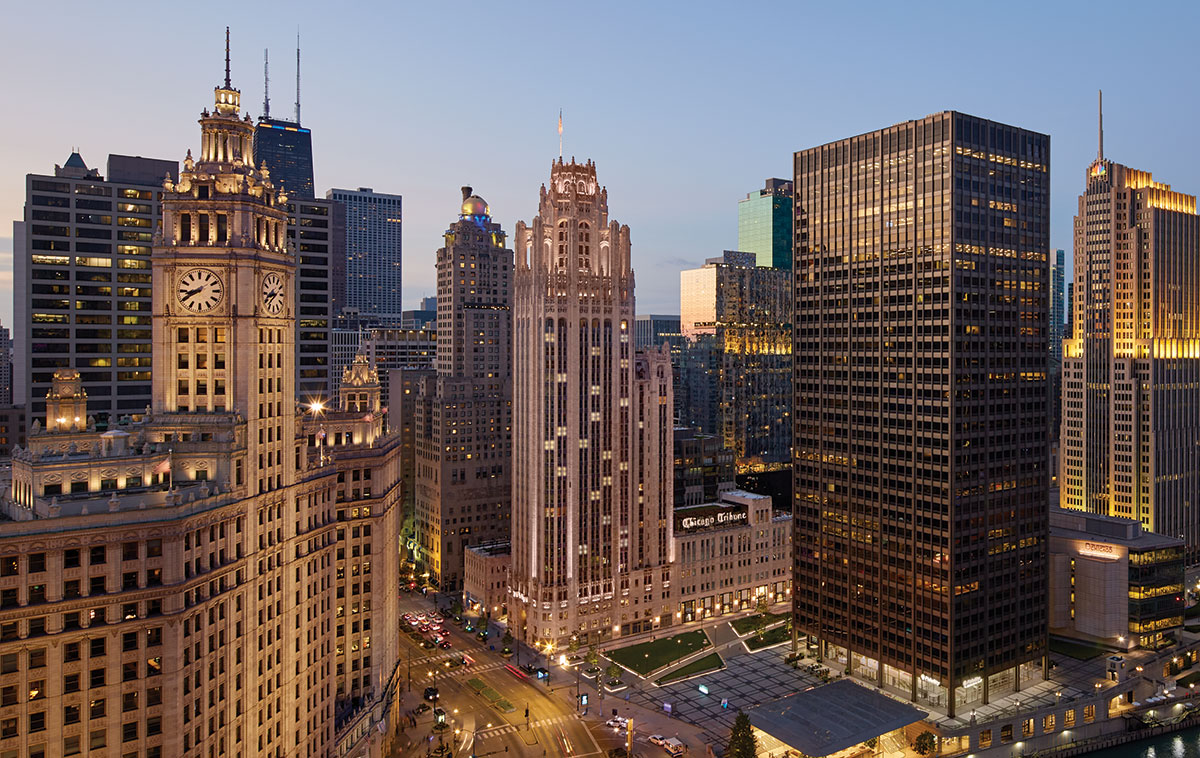
3
At Chicago’s Tribune Tower (3), SCB cut a courtyard (4 & 5) from the base to create floor plates suitable for apartment layouts (6). Images © Dave Burke (3), Darris Lee Harris (4), SCB (5 & 6)
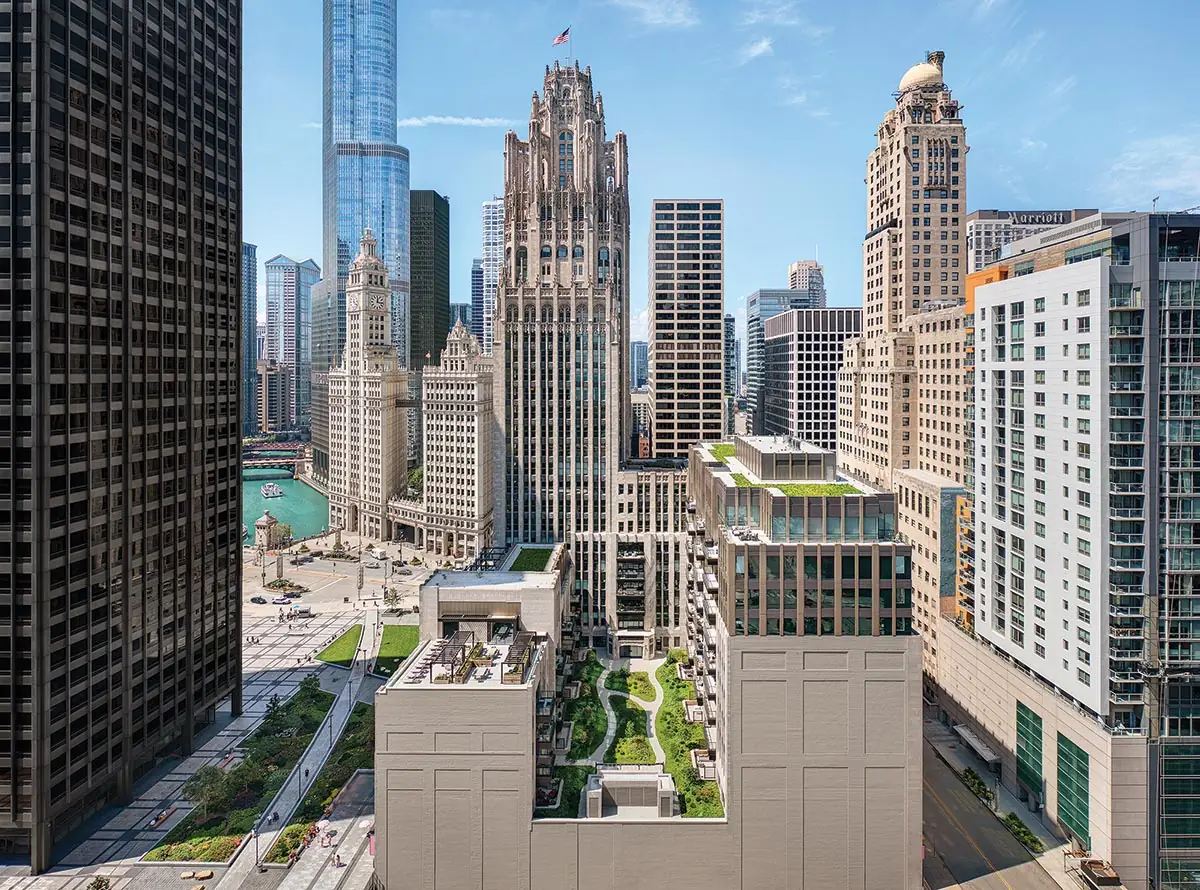
4
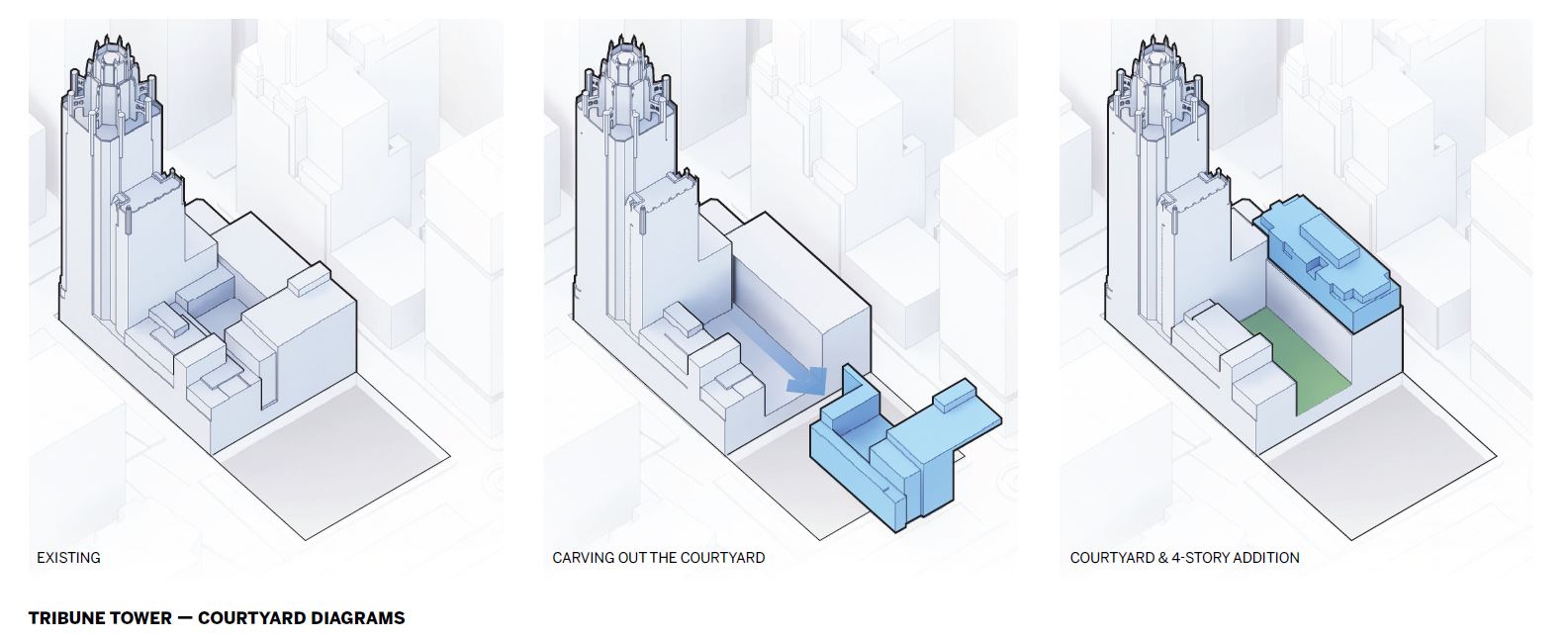
5
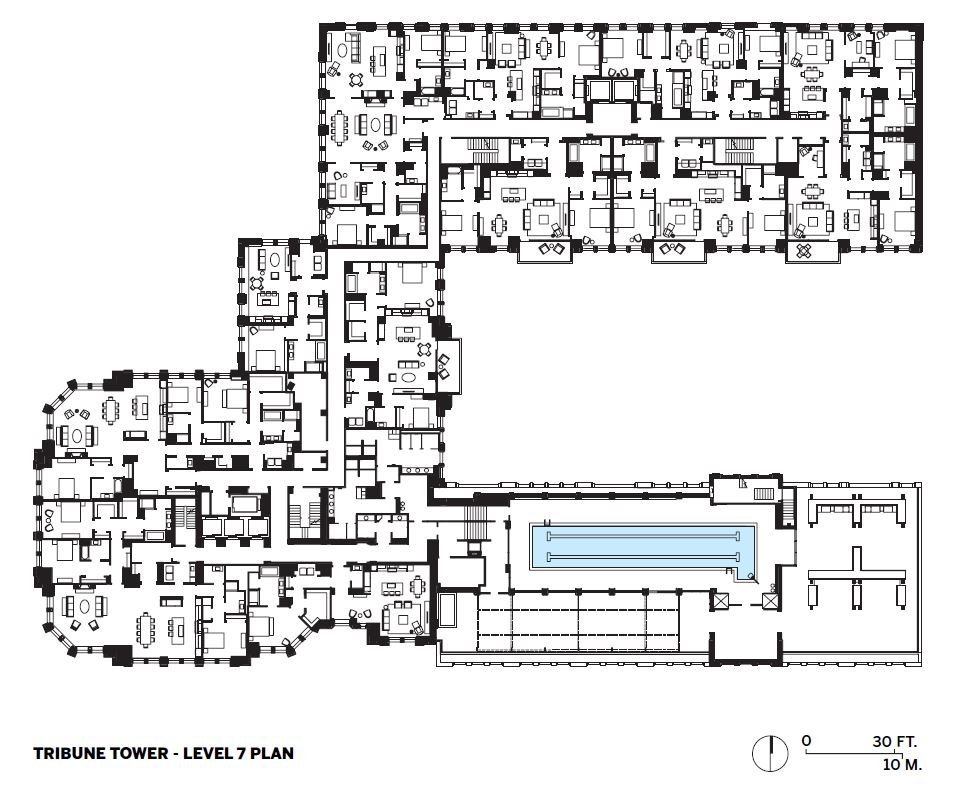
6
Conversion of the Tribune Tower’s base—a 65,000-square-foot assemblage of three buildings, erected between 1920 and 1950, in heights ranging from four to eight stories—required a different approach. There, SCB carved an 80-foot-wide landscaped courtyard out of the structures, stiffening steel column-and-beam connections to make up for the loss of lateral support. The courtyard left behind two wings on either side, narrow enough to host desirable residential layouts. The foundation’s load-bearing capacity allowed the addition of four floors on one of the wings, creating what SCB associate principal Steve Hubbard refers to as “very valuable” units.
Deep-Floor Dilemma
Large office structures with deep floor plates are particularly challenging to convert, because so much of their floor space is too far from windows to be desirable (or, in many jurisdictions, legal). These buildings, mainly from the 1950s through the 1980s, may have deteriorated fixed-glass curtain walls, unlike older towers that came with operable windows. If their potential can be unlocked, they can deliver a great number of units and take some of the least desirable buildings out of the office inventory.
Such conversions can entail removing building volume to provide more perimeter for capturing daylight, breezes, and views, as was done at the Tribune Tower’s base. In a speculative project in this vein, ARO proposed removing square footage from the bulky base of a 21-story wedding-cake setback tower completed in 1952 in Manhattan by Sylvan Bien. ARO placed the removed square footage atop higher floors, shaping new setbacks and terraces to add value to the apartments. Such radical reshaping is not as daunting as it sounds, says Yarinsky. “We proposed to add new loads where we assumed the load capacity already existed, in this way minimizing burdens on the foundations and structure.”
A similarly theoretical scheme was created by SOM for an ideas competition sponsored by the trade organizations the Steel Institute of New York and the Ornamental Metal Institute of New York. The brief called for the conversion of 1633 Broadway, a 48-story, 2.5 million-square-foot tower with deep floor plates designed by Emery Roth & Sons in Manhattan’s Times Square. “The sponsors selected about the toughest building for conversion they could find,” says Mahan. But its great size “also justifies significant massing and structural modifications.” The firm’s entry opened up the monolithic rectangular slab of the 1971 tower by cutting six courtyards in, strategically reinforcing the structural frame, and stacking the removed square footage in a stepped volume atop the building. The scheme diversified the incomes of residents by dividing the building vertically into adjoining condo, affordable housing, and co-living towers atop a base of commercial, institutional, and cultural uses. Like other competing projects, its ideas are speculative, but they broaden the spectrum of building-reuse possibilities.
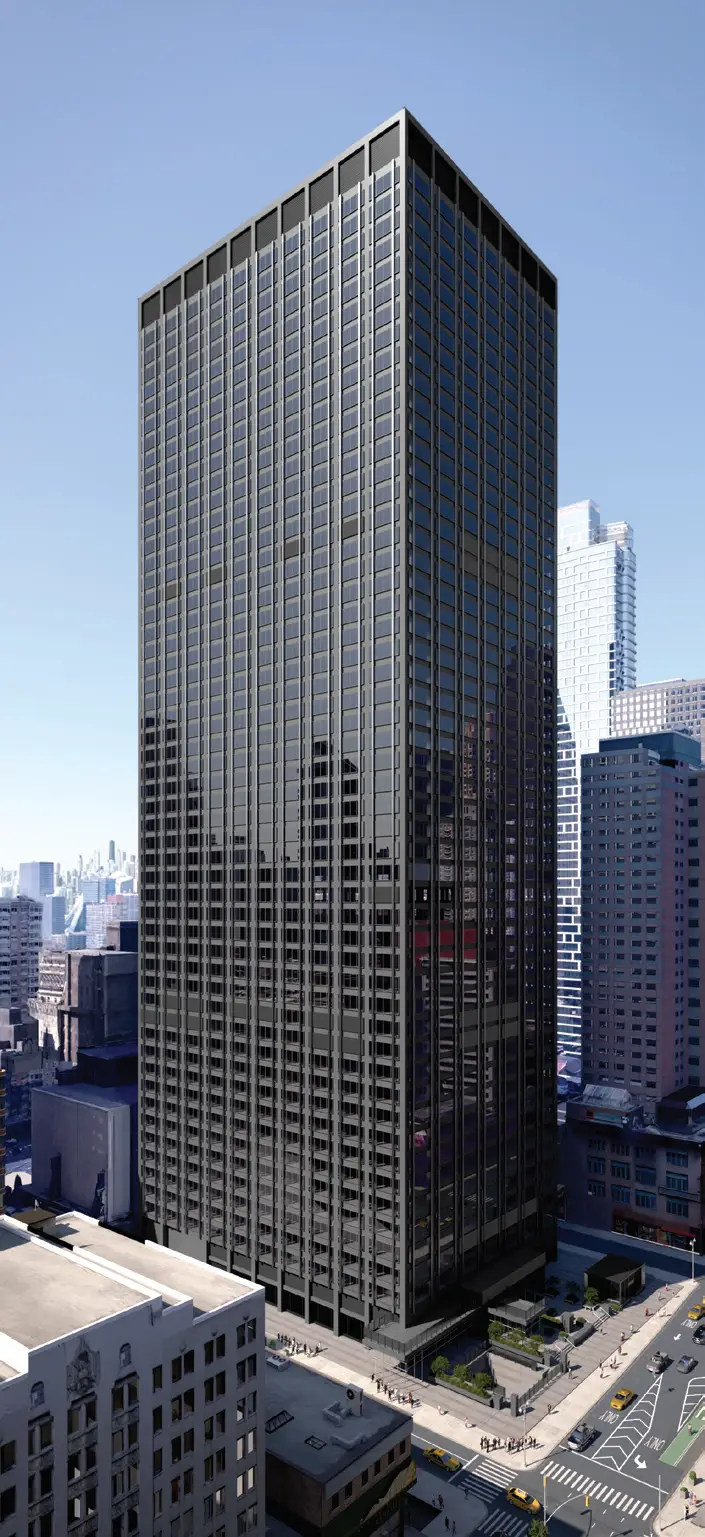
7
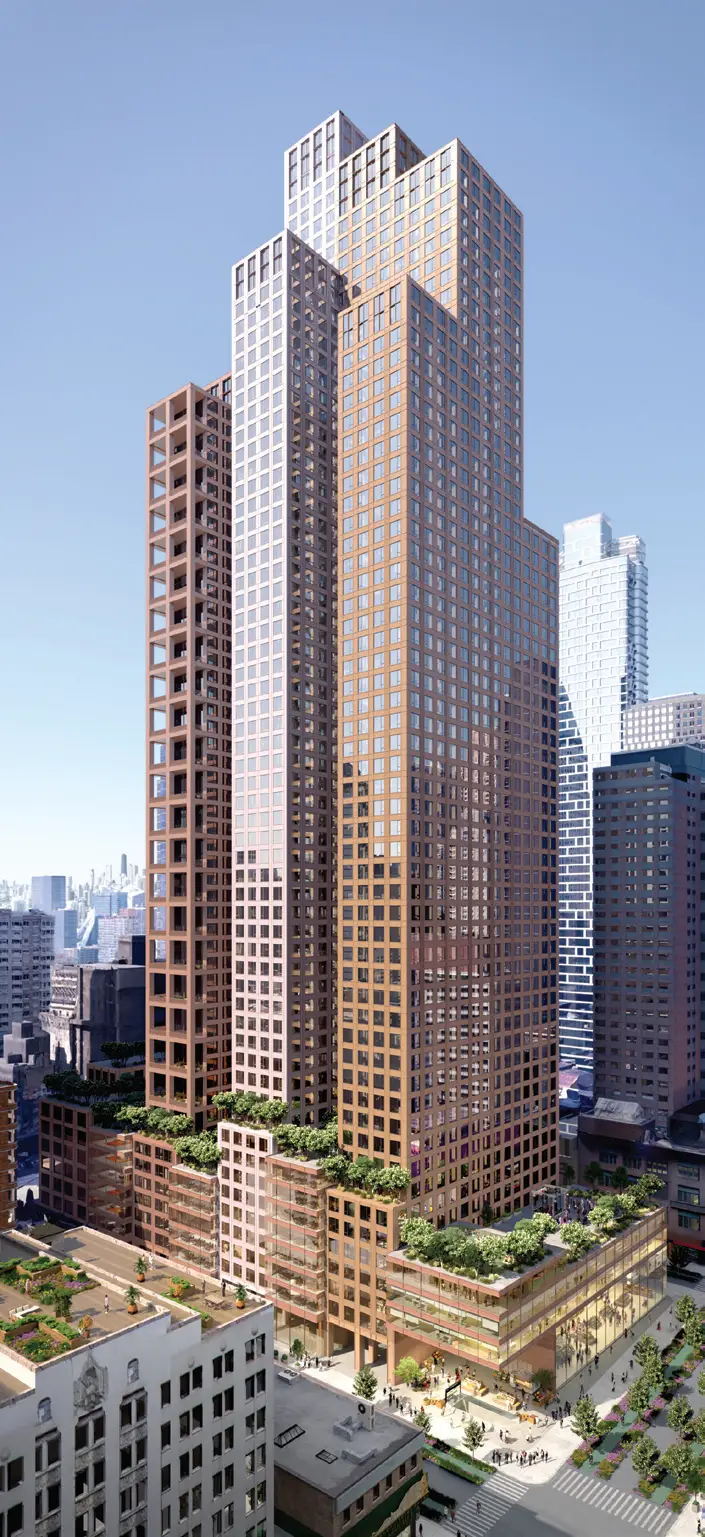
8
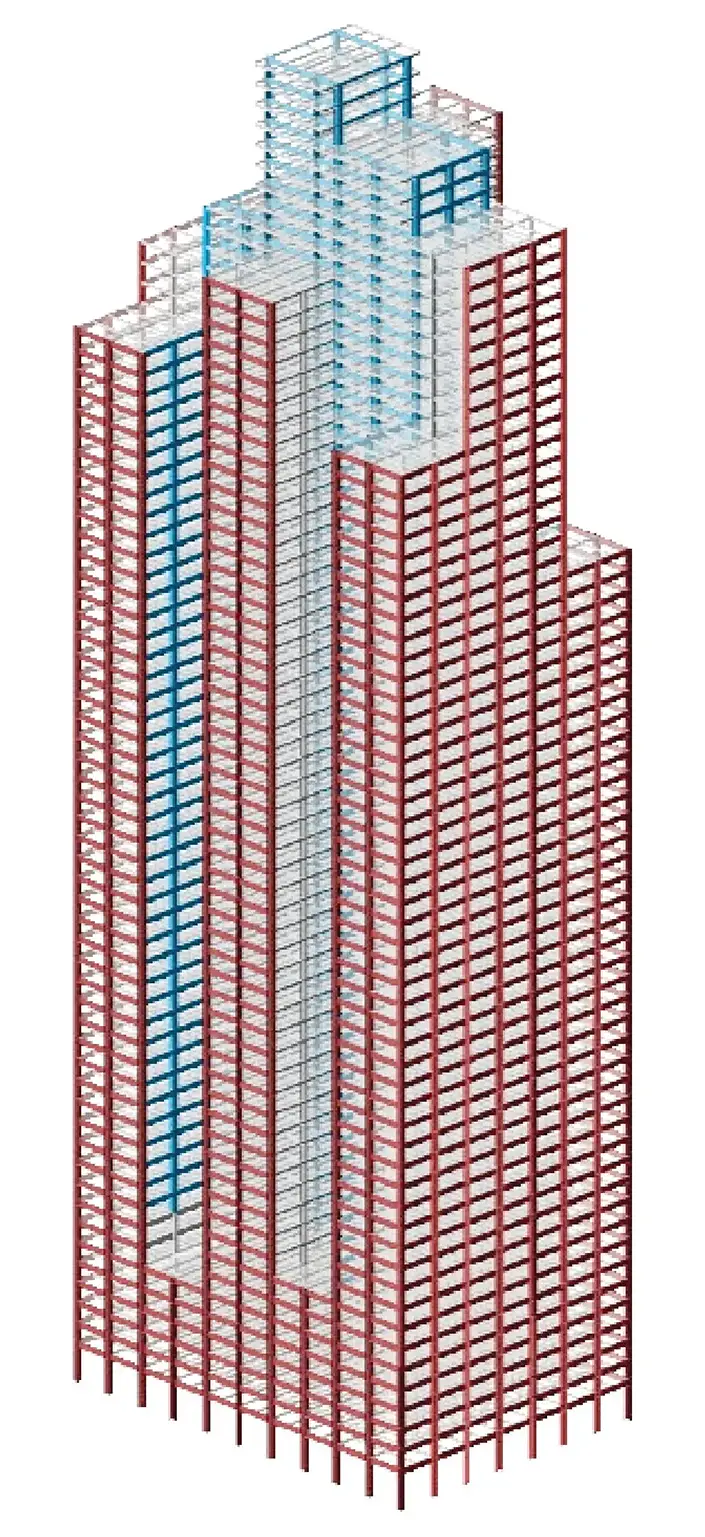
9
For an early 1970s office building (7) in New York’s Times Square, SOM has proposed removing building volume (11) and stacking it to create a stepped tower (8). Strategically stiffening the frame (diagrams 9 & 10) would limit drift. Images © SOM (7, 9, 10, 11), SOM/Miysis (8)

10
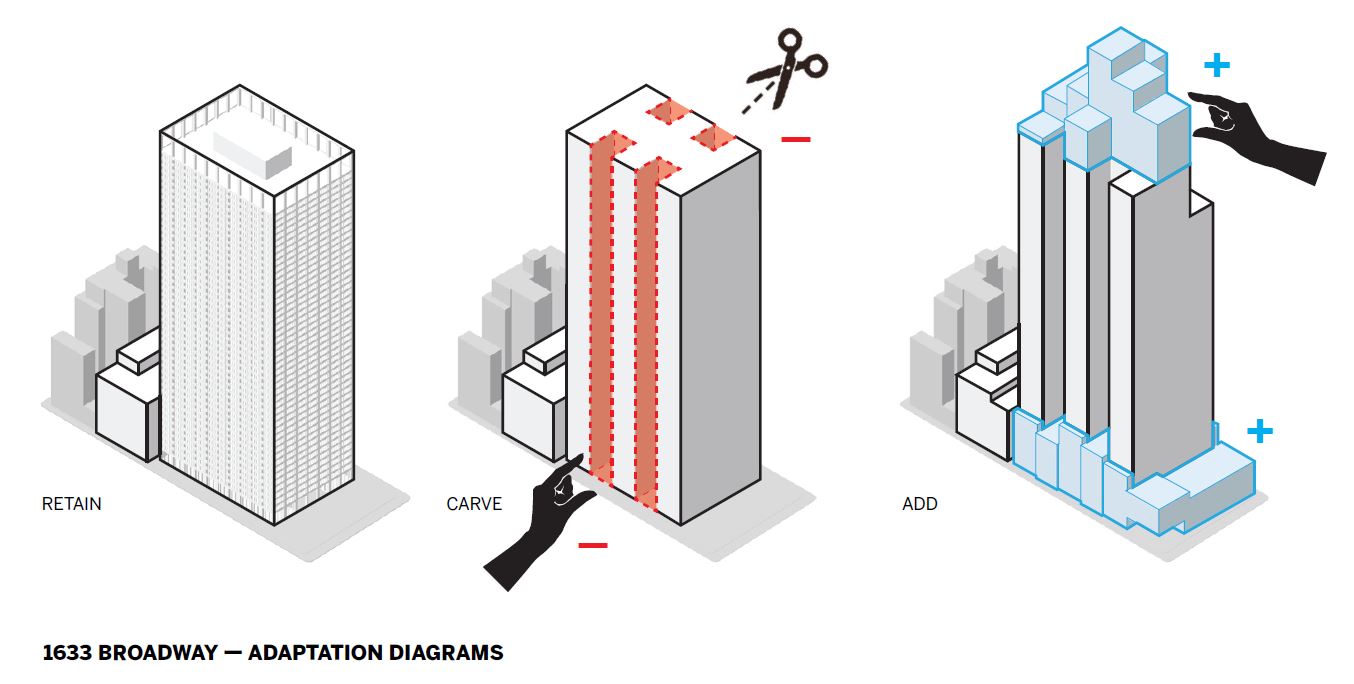
11
Especially when converting buildings constructed since the 1950s, the exterior walls represent a particularly difficult problem. With expanses of fixed tinted glass and substandard energy performance, their curtain walls will probably warrant replacement with thermally efficient envelopes that include operable windows, a requirement for living spaces and bedrooms in many jurisdictions. But such retrofits, if the new exterior walls are highly insulated, can also allow mechanical systems to be considerably downsized, slashing energy costs, points out ARO’s Yarinsky.
To enable a greater number of conversions, cities may need to alter building codes and zoning regulations. New York is looking at reducing the size of required operable bedroom windows, as well as a currently mandated clear area around them, says Yarinsky, because many candidates for adaptation are unable to comply. Developers maintain that making such openings optional would render conversions more affordable. There’s pushback, however, from those who argue that rooms dependent on mechanical ventilation become uninhabitable in the event of power failures, and that the wellness benefits of light, air, and views of greenery should trump the cost consideration. “Must we return our buildings to Dickensian horror?” asks Ian Lomas, a principal at the Los Angeles office of Woods Bagot.
Other policies under consideration in New York, aimed at spurring more conversions of office buildings into housing—especially affordable housing—include changes that would allow residential development in parts of the city currently zoned only for office space and manufacturing, and the launch of an Office Conversion Accelerator program to help owners expedite projects. Meanwhile, in San Francisco, Mayor London Breed’s administration has issued a Request for Interest, asking downtown building owners and developers for conversion ideas for their underutilized building stock. The hope is to identify projects where the city could speed up or enhance such projects through zoning or regulatory changes. Similarly, in Chicago, the LaSalle Reimagined initiative, whose goal is to revive what was once considered Chicago’s Wall Street, includes incentives to hasten the transformation of office towers into residential buildings. Five developers and five properties (all but one built before World War II) were selected as finalists earlier this year. According to the city, the conversion projects represent nearly $1 billion in investment and will create 1,600 units, 600 of them affordable.
The Chicago program also has a retail component that would support street-level businesses serving the LaSalle corridor’s new residents while also addressing the post-Covid loss of foot traffic. Qualifying businesses can receive grants for such projects as storefront upgrades, interior renovations, and design fees.
Of course, converting underutilized commercial properties not only has the potential to reinvigorate once-lively downtowns and satisfy a huge need for housing, but, as Lomas, the Woods Bagot principal (who also worked in London), points out, there’s an importance to history. “In Europe, there’s always an assumption that what’s gone before has value,” he says. “There is an emotional connection. You add the layering you need to that.”
Continuing Education

To earn one AIA learning unit (LU), including one hour of health, safety, and welfare (HSW) credit, read the article above and “Converting Brown Offices to Green Apartments” (Through page 4), National Bureau of Economic Research Working Paper 3150, August 2023; then complete the quiz.
Upon passing the quiz, you will receive a certificate of completion, and your credit will be automatically reported to the AIA. Additional information regarding credit-reporting and continuing-education requirements can be found at continuingeducation.bnpmedia.com.
Learning Objectives
- Discuss the economic, environmental, and social arguments for converting vacant office buildings into housing.
- Describe different office-building typologies and discuss the conversion challenges they pose.
- Discuss structural retrofit measures that may be required to convert an office building into housing.
- Outline code, zoning, and other regulatory changes that could hasten transformation of vacant office towers into housing.
AIA/CES Course #K2310A




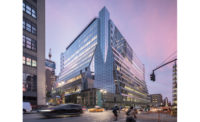
Post a comment to this article
Report Abusive Comment